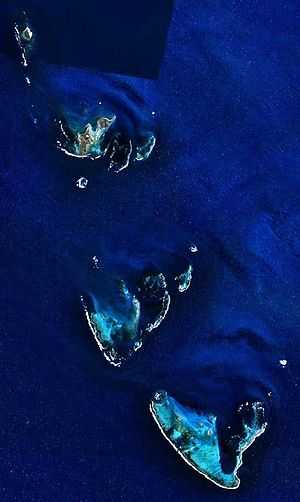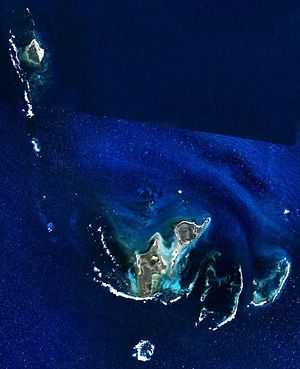Wallabi Group
The Wallabi Group is the northern-most group of islands in the Houtman Abrolhos. Nominally located at 28°28′S 113°42′E / 28.467°S 113.700°ECoordinates: 28°28′S 113°42′E / 28.467°S 113.700°E,[1] it is 58 kilometres from the Australian mainland, and about 9 kilometres from the Easter Group.[2]
The group consists of a number of islands arising from a carbonate platform 17 kilometres long and up to 10 kilometres wide, and also the outlying North Island, located 14 kilometres to the northwest of the main platform. The main islands are North Island, West Wallabi Island, East Wallabi Island, Long Island and Beacon Island.[2] The group is part of the Houtman Abrolhos Important Bird Area, identified as such by BirdLife International because of its importance for supporting large numbers of breeding seabirds.[3]
The Wallabi Group is best known for the shipwreck of the Batavia on Morning Reef near Beacon Island in 1629,[4] and the subsequent mutiny and massacres that took place among the marooned survivors.[5] Another wreck for which a location is known is the Hadda, which was wrecked off Beacon Island in April 1877[6] and now lies about a kilometre north of it.[7]
Components of the island group
- Acute Bank
- Assail Bank
- Beacon Island
- East Wallabi Island
- Long Island
- North Island
- North East Reef
- Pigeon Island (Houtman Abrolhos)
- Shag Rock (Houtman Abrolhos)
- South Passage (Houtman Abrolhos)
- Suda Bay Passage
- The Flat (Houtman Abrolhos)
- Traitors Island
- West Wallabi Island
See also
References
- ↑ "Wallabi Group". Gazetteer of Australia online. Geoscience Australia, Australian Government.
- ↑ 2.0 2.1 "Houtman Abrolhos". oceandots.com. Retrieved 2007-10-13.
- ↑ "IBA: Houtman Abrolhos". Birdata. Birds Australia. Retrieved 2011-08-12.
- ↑ "Batavia". Western Australian Shipwrecks Database. Department of Maritime Archaeology, Western Australian Museum.
- ↑ Dash, Mike (2002). Batavia's Graveyard. Great Britain: Weidenfeld & Nicolson. ISBN 0-575-07024-2.
- ↑ "Hadda". Western Australian Shipwrecks Database. Department of Maritime Archaeology, Western Australian Museum.
- ↑ Australia 1:100000 Topographic Survey, Map sheet 1641 (Edition 1): Wallabi


.jpg)